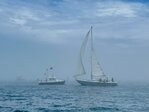


Sailors fear very few things. Among these are fog, lightning, dismasting, fire at sea, and running out of rum. The most prevalent of which is fog. It is disorienting, unnerving, and ramps up the terror of running into things, or worse, being run-down by bigger craft.
The start of this year’s Crocker race was threatened first by thunderstorms and then by the occurrence of … fog. But the Race Committee, following protocol, postponed the start by 90 minutes, first to allow for the passage of a band of dangerous looking precipitation, and then because of dense fog which reduced visibility to just a few boat lengths. As the 30 race boats converged on the starting area at Gales Ledge, we on
the Committee Boat suddenly felt very small, as if being strafed by large sailboats who needed to keep a visual fix on the line before their start time.
In this “pursuit race”, the smallest boat, a Rhodes 19 skippered by Steve Hamilton, started first and was followed across the line by the larger boats, each with their own start time set by formula. The fastest boat in the fleet, the 40-foot Ricochet, began the race 40 minutes later. The theory behind a pursuit race is that given the handicaps, all the boats should arrive at the finish at roughly the same time. The course is a simple 12-mile triangle beginning at the Gales Ledge Nun. From the starting line, the racers sailed south on a beat to Newcomb’s Ledge, then ran under spinnaker northeast to Gloucester, and finally returned on port tack up the Manchester shoreline to Gales Ledge.
After the race, fortified by their rum and the copious spread on the MYC deck, many sailors spoke about the rare sightings of the buoys and competitors, and the brilliant (or perhaps unsuccessful) tactics of their navigators and skippers to get them round the marks as quickly as possible. As ever, the need to rely on navigational instruments rather than eyesight meant that their racing tactics were often stymied by the basic problem of trying to find the next mark in less than 50-yard visibility. Imagine trying to kick a field goal when there are no grid lines on the field, you’ve been turned around during play, and you can’t even see the goalpost!
Charlie Thomas said: “It was eerie knowing that there were 30 boats out there, but most of the time we couldn’t see anyone.” Mory Creighton reported, “It was a wonderful day of ocean racing for those that like to test their navigation and sailing skills in dense fog. We had visibility less than 50 yards at times. We had a fun time sailing and peering around to see who was with us,
crossing paths and ghosting along in the fog. The run back from Eastern Point to the finish was memorable on a close reach with flat seas, steady wind, and a bit of a challenge finding Trident on the finish line.
Philip Leahy commented, “Looking at AIS (a vessel location app) a lot to see what other boats were up to. Fun to see all the boats at the marks, only to lose them again after a few minutes. And the comments over the VHF (radio) were very amusing.”
Standout performance in the race was achieved by John Gero, in a Crocker-designed boat, which was also the only wooden boat on the course, and the winner in Class F.
The overall honors for the race went to the Class B winner, Virgo, skippered by Dan Rabin, which finished a substantial eight minutes ahead of the second-place boat, No Quarter, skippered by Matt Herbster. The top MYC finishers were Carl Doane’s Incentive (4th), John Filias’ Blue Agave (5th) and David Martz’s Osprey (11th).
As befits a race like this, the fog lifted just as the last boat crossed the finish line.
Tony Leggett is the S.S. Crocker Race Committee chair. For information and details, email him at anthonyleggett76@gmail.com